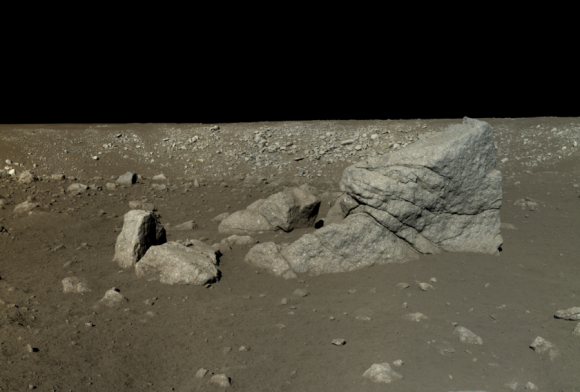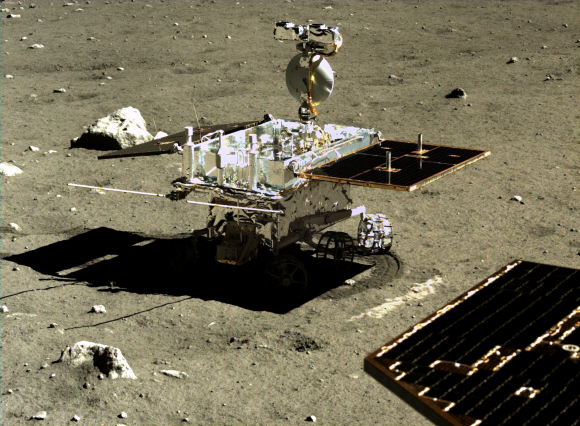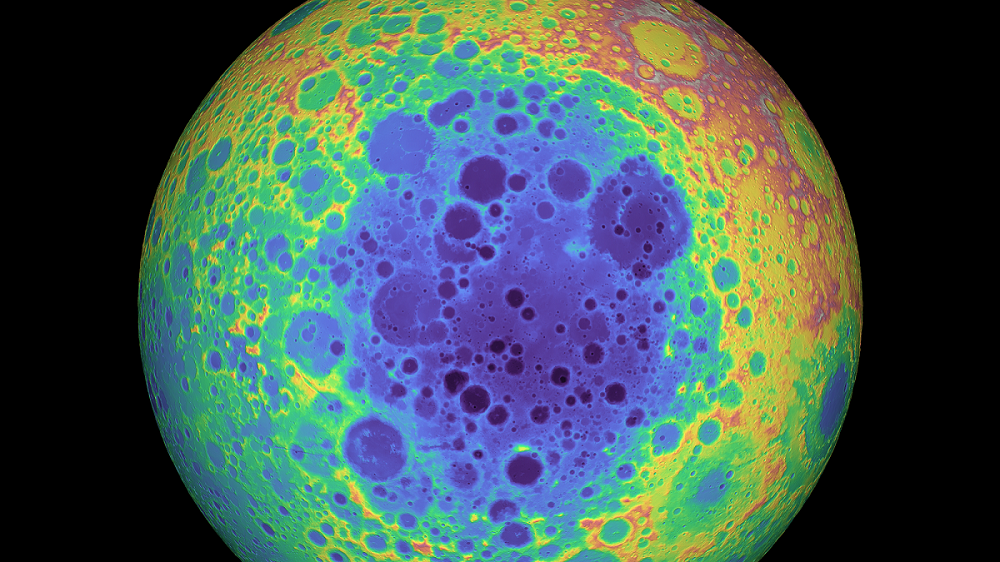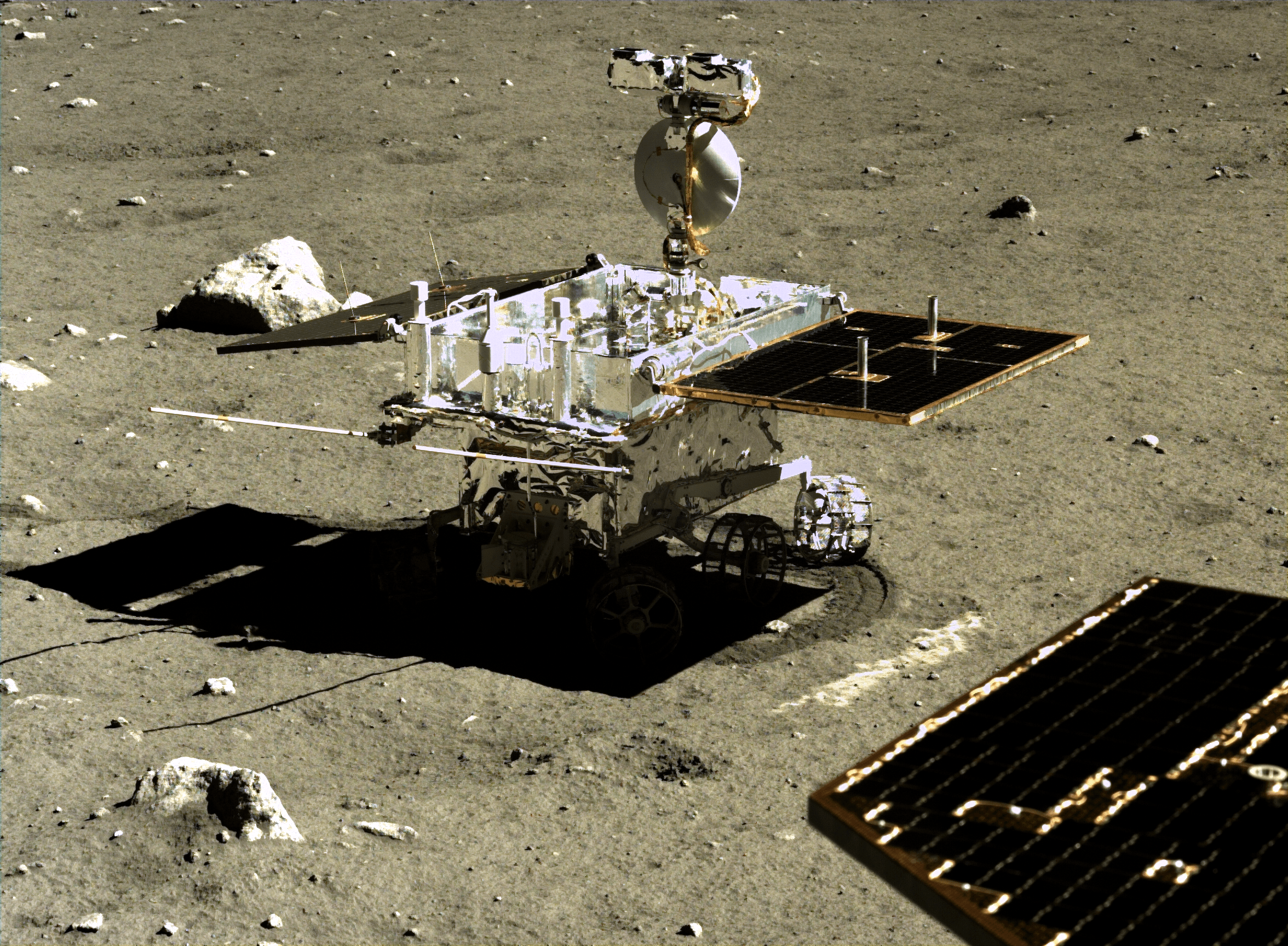

Johns Hopkins University (JHU) continues to pad its space community résumé with their interactive map, “The map of the observable Universe”, that takes viewers on a 13.7-billion-year-old tour of the cosmos from the present to the moments after the Big Bang. While JHU is responsible for creating the site, additional contributions were made by NASA, the European Space Agency, the National Science Foundation, and the Sloan Foundation.

China plans lunar far side landing with hardware similar to Chang’e-3 lander
This time-lapse color panorama from China’s Chang’e-3 lander shows the Yutu rover at two different positions
during its trek over the Moon’s surface at its landing site from Dec. 15-18, 2013. This view was taken from the 360-degree panorama.
Credit: CNSA/Chinanews/Ken Kremer/Marco Di Lorenzo.

Mosaic of the Chang’e-3 moon lander and the lunar surface taken by the camera on China’s Yutu moon rover
from a position south of the lander during Lunar Day 3. Note the landing ramp and rover tracks at left.
Credit: CNSA/SASTIND/Xinhua/Marco Di Lorenzo/Ken Kremer Mosaic of the Chang’e-3 moon lander and the lunar surface taken by the camera on China’s Yutu moon rover from a position south of the lander during Lunar Day 3.
Note the landing ramp and rover tracks at left. Credit: CNSA/SASTIND/Xinhua/Marco Di Lorenzo/Ken Kremer

360-degree time-lapse color panorama from China’s Chang’e-3 lander. This new 360-degree time-lapse color panorama
from China’s Chang’e-3 lander shows the Yutu rover at five different positions, including passing by crater and heading south
and away from the Chang’e-3 lunar landing site forever during its trek over the Moon’s surface at its landing site from
Dec. 15-22, 2013 during the 1st Lunar Day. Credit: CNSA/Chinanews/Ken Kremer/Marco Di Lorenzo – kenkremer.com.
See our Yutu timelapse pano "NASA APOD Feb. 3, 2014

Pyramid Rock, as named by the Chinese. This rock was ejected when the crater immediately behind it was created.
Image: Chinese Academy of Sciences/China National Space Administration/The Science and Application Centre for
Moon and Deep Space Exploration/Emily Lakdawalla.

This is a 360 degree panoramic image of the rover and part of the lander.
Bright white rocks litter the rim of the crater on the left.
Image: Chinese Academy of Sciences/China National Space Administration/
The Science and Application Centre for Moon and Deep Space Exploration/Emily Lakdawalla.

This image shows a lot of detail of the Yutu rover. Image: Chinese Academy of Sciences/China National Space Administration
/The Science and Application Centre for Moon and Deep Space Exploration/Emily Lakdawalla.

A high ranking member of China's secretive space agency has surprisingly revealed details on the nation's ambitious plans for exploring both the moon and Mars. Architect of the country's impending missions, Wu Weiren, provided the BBC with remarkable insight into the heretofore unknown intentions for China's space agency. He told the broadcaster that they hope to soon both orbit as well as land on the moon in order to obtain samples from the celestial body. That would merely be the initial stage of China's presence on the moon as Weiren says that they aim to ultimately establish a manned research base there. A key factor in their aspirations reside on the far side of the moon, where China believes there may be water and ice that could prove to be valuable resources to future lunar denizens. However, as might be expected given the state of current space exploration, China has begun setting their sights on Mars as a longterm goal for exploration. In an intriguing revelation, Weiren indicated that the Chinese space agency was limited by their own government as far as allocating resources towards a Martian mission. With that stance seemingly having changed, the agency is confident that it will reach the Red Planet by 2021 in an elaborate mission. "We will orbit Mars, land, and deploy a rover - all in one mission," Weiren declared to the BBC. Despite their lofty expectations, China faces a unique challenge due to the nature of their space agency. Since it is part of the Chinese military, NASA is forbidden for working with them and the European Space Agency has only collaborated with them on one mission. As such, the isolationist space agency has been forced to rely on Russian help as well as their own vast resources of scientists. Weiren expressed hope that the stalemate with the United States can come to an end and both countries could work together to explore space. Whether that proves to be case remains to be seen, but it may be in everyone's best interests rather than a space war over land and resources from the moon and beyond. Source: BBC News

The Chinese lunar rover, part of the upcoming Chang'e 4 mission to the far side of the Moon. Credit and ©: CASC/China Ministry of Defense

The Chinese Yutu rover, part of the Chang’e 3 mission, on the Moon. Credit: CNSA

Ever since it made its historic landing on Jan. 3rd, 2019, the Chang’e-4 mission and its Yutu 2 rover have been busy exploring the lunar surface. Just recently, the mission passed its first year of operations and earned the distinction of being the first rover to travel a record 357.695 meters (1,173.5 ft) on the far side of the Moon. And in between all that, the mission has also provided some truly fascinating images of the lunar surface.

Image of the Chang’e-4 lander, taken by the Yutu 2 rover. Credit: CNSA/GRAS/Doug Ellison

Thanks to @zengxingguo 's pointers I got it work! Here's a random image -- 4 mega pixels -- from #ChangE4/#Yutu2's PanCAM, taken just a month ago (19/12/02). The full DR1 (38 GB!) can be accessed at CLEP's PDS at

Cylindrical panoramic of the Yutu 2 rover. Credit: CNSA/GRAS/Doug Ellison

elevation data of the Moon, highlighting the low-lying regions of the South Pole-Aitken Basin. Credit: NASA/GSFC/University of Arizona
China launches Queqiao relay satellite to support Chang'e-4 lunar far side landing mission

Since the turn of the century, China has worked hard to become one of the fastest-rising powers in space. In 2003, the Chinese National Space Administration (CNSA) began sending their first taikonauts to space with the Shenzou program. This was followed by the deployment of the Tiangong-1 space station in 2011 and the launch of Tiangong-2 in 2016. And in the coming years, China also has its sights set on the Moon.

Photo taken by China’s Chang’e-4 probe after its landing. Credit: Xinhua

A map showing the permanently shadowed regions (blue) that cover about 3 percent of the moon’s south pole. Credit: NASA Goddard/LRO mission

A render of the Chang’e-4 rover on the lunar surface, released Aug. 15th, 2018. Credit: CASC
New China TV Published on Jan 2, 2019 A historic first landing! China's Chang'e-4 probe touched down on the far side of the moon Thursday,January 3, 2018 becoming the first spacecraft soft-landing on the moon's uncharted side never visible from Earth.

On January 3rd, 2019, China’s Chang’e-4 lander became the first mission in history to make a soft-landing on the far side of the Moon. After setting down in the Von Karman Crater in the South Pole-Aitken Basin, the rover element of the mission (Yutu 2) deployed and began exploring the lunar surface. In that time, the rover has traveled a total of 345.059 meters (377 yards) through previously unexplored territory.

In January 2019, China landed its Chang’e 4 mission on the Moon’s far side. The Yutu-2 rover got busy exploring its surroundings. It’s still going, even though the rover’s nominal operating mission was only three months. Among the mission’s findings was a strange material described as “gel-like.” Now an analysis of the material has revealed that it’s just rock: impact melt breccia.

The small impact crater where the Yutu-2 rover found the gel-like material. It’s lightly highlighted in the center of the image. Image Credit: China Lunar Exploration Program.

This image shows the Yutu rover leaving the lander area and making its way on the lunar surface. Image: Chinese Academy of Sciences/China National Space Administration/ The Science and Application Centre for Moon and Deep Space Exploration/Emily Lakdawalla.

This image shows the Yutu rover leaving the lander area and making its way on the lunar surface. Image: Chinese Academy of Sciences/China National Space Administration/ The Science and Application Centre for Moon and Deep Space Exploration/Emily Lakdawalla.
Geologists think they’ve found the oldest Earth rock ever seen. And they found it in one of the last places you’d ever suspect, on the Moon. When the Apollo 14 astronauts returned their lunar samples back to Earth, they were carrying one rock that had formed on Earth 4 to 4.1 billion years ago, which was carved out of our planet during the time of intense bombardment and delivered to the Moon. Audio Podcast version: : ITunes RSS: Video Podcast version: ITunes: RSS:
Sign up to my weekly email newsletter: Support us at:Support us at: Follow us on Tumblr: More stories at Follow us on Twitter: @universetoday Like us on Facebook: Instagram - Team: Fraser Cain - @fcain / frasercain@gmail.com /Karla Thompson - @karlaii Chad Weber -

Visualization of the ILRS, from the CNSA Guide to Partnership (June 2021). Credit: CNSA

Illustration of NASA astronauts and the elements of the Artemis Base Camp operating around the Moon’s southern polar region. Credit: NASA

Artist rendering of an Artemis astronaut exploring the Moon’s surface during a future mission. Credit: NASA

Image from a video animation showing the lunar research station discussed by the CLEP Chief Designer, Weiren Wu. (Credit: China Media Group)
China is moving faster towards the completion of the basic model of its ambitious phase-four lunar probe missions and has full confidence in leaving footprints of the Chinese people on the moon by 2030, according to chief designer of the lunar exploration program. CCTTV PLUS News Agency Welcome to subscribe us on: Facebook: Twitter: : LinkedIn Video on Demand: If you are in demand of this video footage, please contact with our business development team via email:

Image of the Yutu-2 rover traversing away from the Chang’e-4 lander in January 2019. (Credit: China National Space Administration)
As NASA prepares to return to the Moon by 2024 as part of its Artemis program, the agency is focusing its efforts on exploring the Moon’s polar regions. These are areas of the Moon which seem to have a lot of water mixed in with the regolith. Some of these craters are permanently in shadow, and might still have large quantities of water, that’s accessible to human and robotic explorers. This is a critical resource, and the Moon might be just the place to help humanity as it pushes out to explore the rest of the Solar System. But it might also be an illusion. We really won’t know until we look up close. Audio Podcast version: ITunes: RSS: What Fraser's Watching Playlist: What is Fraser's Watching Playlist: Weekly email newsletter: Sign up to my weekly email newsletter: For Free Support us at:Support us at: Patreon More stories at : Twitch Follow us on Twitter: @universetoday Like us on Facebook: Instagram - Team: Fraser Cain - @fcain / contact fraser via e-mail Karla Thompson - @karlaii / / @karlathompson001 Chad Weber - weber. References: 50 Years Ago: Lunar Landing Sites Selecte . https://curator.jsc.nasa.gov/lunar/">Lunar Rocks and Soils from Apollo Missions What thickness/depth of water would be required to provide radiation shielding in Earth orbit? .. Lunar Prospector Hydrogen Concentration - South Pole NASA’s LRO Sheds Light on Lunar Water Movemen . What is LCROSS, the Lunar Crater Observation and Sensing Satellite? Inside Dark, Polar Moon Craters, Water Not as Invincible as Expected, Scientists Argue Chang'e 4 Lander: A Closer Look Chandrayaan Mission launch South Korea's first lunar mission planned for 2020 NASA Selects 12 New Lunar Science, Technology Investigations The Planetary society NASA selects UMD-led proposal to upgrade lunar instruments placed by Apollo missions NASA Picks Geosciences Faculty Member's Instrument for Moon Landing

Image from a video animation showing the lunar research station discussed by the CLEP Chief Designer, Weiren Wu. (Credit: China Media Group)